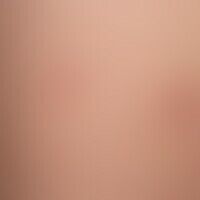Image diagnoses for "Leg/Foot"
395 results with 1158 images
Results forLeg/Foot

Brucellosis (overview) A23.9
Brucellosis. One month after a vacation on a farm, occurrence of several acute, pinhead-sized red papules localized on the lower legs, disseminated, blurred, flatly elevated, low consistency proliferated, red papules in a 16-year-old female patient. Besides, isolated disseminated pustules.

Pyoderma gangraenosum L88
Pyoderma gangränosum. initial findings lasting for years with therapy resistant ulcers. hypertrichosis after several months of unsuccessful therapy with cyclosporine.

Hypertrophic Lichen planus L43.81
Lichen planus verrucosus, a hypertrophic lichen planus with pseudoepitheliomatous epithelial hypertrophy and scarring that has persisted for years.

Hypertrophic Lichen planus L43.81
Lichen planus verrucosus: Symmetrical infestation of the lower legs, ulcerated in places.

Hypomelanosis ito Q82.3
Incontinentia pigmenti achromians: multiple, permanent (congenital), half-sided on the trunk, partly isolated, partly confluent to larger areas, blurred, symptomless, bright spots, running along the Blaschko lines.

Acrodermatitis chronica atrophicans L90.4
Acrodermatitis chronica atrophicans. clearly visible, flabby skin atrophy and edematous redness on the right foot in a serologically proven infection with borrelia. the comparison to the left leg shows the clear difference. the patient spends several months in the black forest every summer.

Lymphedema secondary I89.0, 197.2
Lymphedema secondary: diffuse, uniform swelling of the right lower extremity with papillomatosis cutis lymphostatica. Known CVI. If the patient stands for a longer period of time the swelling increases significantly.

Aggressive cytotoxic epidermotropic cd8-positive t-cell lymphoma C84.5
Aggressive cytotoxic epidermotropic CD8-positive T-cell lymphoma: generalized, rapidly spreading red itchy plaques; retracted scars after formation of ulcerated, deep-seated nodules.

Fixed drug eruption L27.1
Drug reaction, fixed (detail). two red, sharply defined, moderately itchy plaques, existing for a few days. the peripheral areas are lighter in colour, tendency to blistering in the centre. irregular intake of headache medication known and admitted.

Dermatitis contact allergic L23.0
Dermatitis contact allergic: Chronic recurrent, massively itching, disseminated red papules and papulo vesicles confluent to blurred plaques. maceration of the 4th CRC. The skin lesions were caused by application of a cream containing gentamicin.

Artifacts L98.1
Artifacts: Multiple weeping ulcers without apparent reason, non-itching flat ulcers up to 3.0 cm in diameter in an otherwise completely healthy patient.

Lymphedema secondary I89.0, 197.2
Secondary lymphedema: chronic venous insufficiency with pronounced secondary lymphedema.

Necrobiosis lipoidica L92.1
Necrobiosis lipoidica: Necrobiosis lipoidica that has existed for several years. Large, atrophic scarring (translucent vessels) in the centre. Reddened progression zone at the edges.

Necrobiosis lipoidica L92.1
Necrobiosis lipoidica: bilateral, gradually increasing, sharply defined, confluent, reddish-brownish, centrally distinctly atrophic plaques that have existed for about 2 years, increasing in consistency over the entire plaque.

Pityriasis lichenoides (et varioliformis) acuta L41.0
Pityriasis lichenoides et varioliformis acuta: acutely occurring "colorful" exanthema with differently sized papules measuring 0.2-0.8 cm, erosions, and encrusted ulcers.

Livedo reticularis I73.83
Livedo reticularis: Thigh of a 24-year-old woman after sauna with cold shower; additional findings: Cicatrix after excision of a nevus cell nevus in the middle of the thigh.








